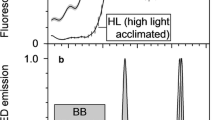Abstract
Orientational movement of chloroplasts was induced by a brief irradiation with red light (R) or blue light (B) in dark-adapted prothallial cells ofAdiantum, whose chloroplasts had gathered along the cell dividing wall (i.e., the anticlinal wall). When the whole dark-adapted prothallia were irradiated from a horizontal direction (i.e., from their lobes) with horizontally vibrating polarized R (H pol. R) for 10 or 3 min, the chloroplast left the anticlinal walls and spread over the prothallial surface (i.e., the periclinal walls) within 1–2 hr after the onset of irradiation, returning to the anticlinal wall (dark-position) within 10 hr. However, vertically vibrating polarized R (V pol. R) for 10 min did not induce the movement towards periclinal walls. The R effect was cancelled by non-polarized far-red light (FR) irradiation just after the R irradiation. Irradiation with H pol. B for 10 or 3 min but not with V pol. B could also induce a similar movement of chloroplasts, although the chloroplasts returned within 4 hr. The effect of H pol. B, however, was not cancelled by the subsequent FR irradiation.
When a part of the dark-adapted cell at the prothallial surface was irradiated from above with a microbeam of R or B for 1 min, chloroplasts of the cell in the dark-position moved towards the irradiated locus in subsequent darkness. However, in the neighboring cells, orientational movement was not induced by either R or B microbeams.
These results show that in dark-adapted prothallial cells, both brief irradiation with R and B can induce chloroplast photo-orientation and that the photoreceptors are phytochrome and blue light-absorbing pigment, respectively. It is also clear that effects of both R and B irradiation do not transfer to neighboring cells.
Similar content being viewed by others
Abbreviations
- B:
-
blue light
- FR:
-
far-red light
- H pol.:
-
horizontally vibrating polarized light
- Pfr:
-
FR-absorbing form of phytochrome
- R:
-
red light
- V pol.:
-
vertically vibrating polarized light
References
Gabryś, H. 1984. Chloroplast movement inMougeotia induced by blue light pulse. Planta166: 134–140.
Gabryś, H., Walczak, T. andZurzycki, J. 1981. Chloroplast translocations induced by light pulses. Planta152: 533–556.
Haupt, W. andHäder, D.-P. 1994. Photomovement.In Kendrick, R.E. and Kronenberg, G.H.M., ed., Photomorphogenesis in Plants. Kluwer Academic Publishers, Dordrecht. pp. 707–732.
Iino, M., Ogawa, T. andZeiger, E. 1985. Kinetic properties of the blue-light response of stomata. Proc. Natl. Acad. Sci. USA82: 8019–8023.
Izutani, Y., Takagi, S. andNagai, R. 1990. Orientation movements of chloroplasts inVallisneria epidermal cells: different effects of light at low- and high-fluence rate. Photochem. Photobiol.51: 105–111.
Kadota, A. andFuruya, M. 1981. Apical growth of protonemata inAdiantum capillus-veneris IV. Phytochrome-mediated induction in non-growing cells. Plant Cell Physiol.22: 624–638.
Kagawa, T., Kadota, A. andWada, M. 1994. Phytochrome-mediated photo-orientation of chloroplasts in protonemal cells of the fernAdiantum can be induced by brief irradiation with red light. Plant Cell Physiol.37: 371–377.
Kagawa, T. andWada, M. 1993. Light-dependent nuclear positioning in prothallial cells ofAdiantum capillus-veneris. Protoplasma177: 82–85.
Murata, T. andWada, M. 1989. Re-organization of microtubules during pre-prophase band development inAdiantum protonemata. Protoplasma151: 73–80.
Neuhaus, G., Bowler, C., Kern, R. andChua, N.-H. 1993. Calcium/calmodulin-dependent and-independent phytochrome signal transduction pathways. Cell73: 937–952.
Okamoto, H., Hirano, Y., Abe, H., Tomizawa, K.-I., Furuya, M. andWada, M. 1993. The deduced amino acid sequence of phytochrome fromAdiantum includes consensus motifs present in phytochrome B from seed plants. Plant Cell Physiol.34: 1329–1334.
Poo, M. andCone, R.A. 1974. Lateral diffusion of rhodopsin in the photoreceptor membrane. Nature247: 438–441.
Pratt, L.H. 1994. Distribution and localization of phytochrome within the plant.In Kendrick, R.E. and Kronenberg, G.H.M., ed., Photomorphogenesis in Plants. Kluwer Academic Publishers, Dordrecht. pp. 163–185.
Quail, P.H. 1991. Phytochrome: A light-activated molecular switch that regulates plant gene expression. Annu. Rev. Genet.25: 389–409.
Senn, G. 1908. Die Gestalts- und Lageverädrung der Pflanzen-Chromatophoren. Engelmann, Leipzig.
Tilney, L.G., Cooke, T.J., Connelly, P.S. andTilney, M.S. 1990. The distribution of plasmodesmata and its relationship to morphogenesis in fern gametophytes. Development110: 1209–1221.
Tsuji, A. andOhnishi, S. 1986. Restriction of the lateral motion of band 3 in the erythrocyte membrane by the cytoskeletal network: dependence on spectrin association state. Biochemistry25: 6133–6139.
Wada, M., Grolig, F. andHaupt, W. 1993. Light-oriented chloroplast positioning. Contribution to progress in photobiology. J. Photochem. Photobiol. B17: 3–25.
Wada, M., Kadota, A. andFuruya, M. 1983. Intracellular localization and dichroic orientation of phytochrome in plasma membrane and/or ectoplasm of a centrifuged protonema of fernAdiantum capillus-veneris L. Plant Cell Physiol.24: 1441–1447.
Wada, M. andSugai, M. 1994. Photobiology of fern.In Kendrick, R.E. and Kronenberg, G.H.M., ed., Photomorphogenesis in Plants. Kluwer Academic Publishers, Dordrecht. pp 783–802.
White, P.R. 1963. The cultivation of animal and plant cells. 2nd ed, Ronald Press, New York.
Yatsuhashi, H., Kadota, A. andWada, M. 1985. Blue- and red-light action in photoorientation of chloroplasts inAdiantum protonemata. Planta165: 43–50.
Yatsuhashi, H. andKobayashi, H. 1993. Dual involvement of phytochrome in light-oriented chloroplast movement inDryopteris sparsa photonemata. J. Photochem. Photobiol. B19: 25–31.
Yatsuhashi, H. andWada, M. 1990. High-fluence rate responses in the light-oriented chloroplast movement inAdiantum protonemata. Plant Science68: 87–94.
Author information
Authors and Affiliations
Rights and permissions
About this article
Cite this article
Kagawa, T., Wada, M. Brief irradiation with red or blue light induces orientational movement of chloroplasts in dark-adapted prothallial cells of the fernAdiantum . J. Plant Res. 107, 389–398 (1994). https://doi.org/10.1007/BF02344062
Received:
Accepted:
Issue Date:
DOI: https://doi.org/10.1007/BF02344062



